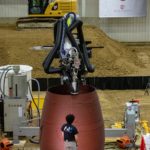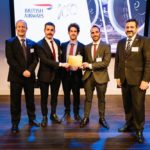Half-scale demonstrator of futuristic ‘Antelope’ delivered in just 60 days
Graduates of the UK’s Royal College of Art’s Intelligent Mobility programme have designed the Antelope, a flying car which could become part of the future of urban transport.
The London-based Master of Arts course attracts designers from across the globe and reflects a world which increasingly requires vehicles to connect, share, electrify and become autonomous. This year, graduates designed the Antelope: a one-seat; carbon fibre; multi-rotor flying vehicle.
The flying car initially demonstrates the ability to hover and tilt to achieve forward motion. The next step will be to take off like a helicopter, which will be followed by a transition to tilted fans.
The achieved speed will generate lift from the body of the car and the Antelope will continue to fly like an aeroplane.
RCA graduates selected ENATA Aerospace to manufacture the half-scale demonstrator design at their facility in Sharjah, UAE. ENATA specialises in advanced unmanned aerial vehicles, radio-controlled planes and multicopters with designs underpinned by advanced composites technology.
Demonstrator delivered in just 60 days
The company used ultra-light aerospace materials and techniques to meet quality and tolerancing standards and to keep weight to an absolute minimum. ENATA Aerospace’s interactive customer progress report system provided daily updates allowing the graduates to monitor the manufacturing process. The 2.5-metre-long, 1.5-metre-wide Antelope, which has a full carbon fibre frame and a body weight of just 9 kgs, was delivered to a challenging deadline of 60 days.
The company used its robotic milling capability to rapidly mill a set of 32 moulds which were used to manufacture the car body. The external surface sandwich panels were moulded from low-density PEI foam and ultra-thin biax carbon fibre non-crimp fabric. This carbon fabric is built up from unidirectional layers at different orientations; using two to three layers of 30 grs.
Carbon fibre and nomex internal structure
The internal structure is made up of sandwich panels using carbon fibre fabrics and a nomex honeycomb core material. All body panels were wet laminated, and vacuum consolidated using female moulds to provide the optimum surface finish.
ENATA chose Sicomin’s SR1700 epoxy system which is specially formulated for the production of high-performance composites such as aerospace applications.
The system has a very low viscosity at ambient temperature and can be used with various hardeners for the vacuum moulding of small or large parts to optimise working time.
Olivier Nicolas, CEO of ENATA Aerospace said: “ENATA has worked with Sicomin on the FOILER, drones and many other composite products for many years. As a result, we had every confidence that Sicomin’s high-quality epoxy resins would be a perfect fit for the revolutionary Antelope flying car concept.”.
Marc Denjean, Export Manager of Sicomin, added: “It has been a pleasure to support ENATA Aerospace with this beautiful and innovative hybrid design and we look forward to continuing our successful collaboration.”

